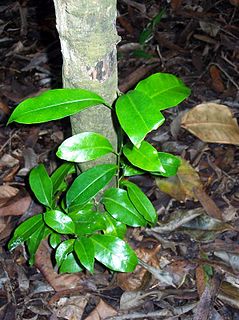
Antidesma is a genus of tropical plant in the family Phyllanthaceae formally described by Linnaeus in 1753. It is native to tropical Africa, S + E + SE Asia, Australia, and various oceanic islands. The greatest diversity occurs in Southeast Asia.

Livistona is a genus of palms, the botanical family Arecaceae, native to southeastern and eastern Asia, Australasia, and the Horn of Africa. They are fan palms, the leaves with an armed petiole terminating in a rounded, costapalmate fan of numerous leaflets.

Amperea is a plant species of the family Euphorbiaceae first described as a genus in 1824. The entire genus is endemic to Australia.

Monotaxis is a plant genus in the family Euphorbiaceae first described as a genus in 1829. The entire genus is endemic to Australia.
- Monotaxis bracteataNees ex Klotzsch - Western Australia
- Monotaxis grandifloraEndl. - Western Australia
- Monotaxis linifoliaBrongn. - New South Wales
- Monotaxis luteifloraF.Muell. - Western Australia, South Australia, Northern Territory
- Monotaxis macrophyllaBenth. - Queensland, New South Wales
- Monotaxis occidentalisEndl. - Western Australia
- Monotaxis paxiiGrüning - Western Australia
- Monotaxis tenuisAiry Shaw - N Western Australia, N Northern Territory

Austrobuxus is a genus of plants under the family Picrodendraceae first described as a genus in 1861. It is native to Southeast Asia, Papuasia, and Australia. The region with the highest diversity is New Caledonia.

Fontainea is a genus constituting part of the plant family Euphorbiaceae. The nine currently known species grow naturally in Queensland (Qld) and New South Wales (NSW) Australia, New Caledonia and Vanuatu, and Papua New Guinea. Some species are commonly named blushwood.

Bertya is a genus of plants in the family Euphorbiaceae first described as a genus in 1845. The entire genus is endemic to Australia.
Dissiliaria is a genus of plants under the family Picrodendraceae described as a genus in 1867.

Breynia is a plant genus in the family Phyllanthaceae, first described in 1776. It is native to Southeast Asia, China, the Indian Subcontinent, Papuasia, Australia, and the island of Réunion.

Asteromyrtus is a genus of flowering plants in the Myrtaceae family. It is closely related to Callistemon and Melaleuca.

Caesia is a genus of herbs in the family Asphodelaceae, subfamily Hemerocallidoideae, native to Australia, New Guinea, Madagascar and Southern Africa. The mostly 3-lobed seed capsules contain rounded black seeds. The genus was named in honour of Federico Cesi (1585-1630), an Italian scientist.
- Caesia alpina Hook.f. - alpine grass-lily - New South Wales, Tasmania, Victoria
- Caesia calliantha R.J.F.Hend. - blue grass-lily - New South Wales, Tasmania, Victoria, South Australia
- Caesia capensis(Bolus) Oberm. - Cape Province of South Africa
- Caesia chlorantha F.Muell. - New South Wales, Queensland, Western Australia
- Caesia micrantha Lindl. - New South Wales, Tasmania, Victoria, South Australia, Western Australia, Queensland
- Caesia occidentalis R.Br. - Western Australia
- Caesia parviflora R.Br. - pale grass-lily - Queensland, New South Wales, Tasmania, Victoria, South Australia, Western Australia
- †Caesia rigidifolia F.Muell. - Queen Victoria Springs in Western Australia but extinct. Last recorded near Zanthus in 1875.
- Caesia sabulosaBoatwr. & J.C.Manning - Cape Province
- Caesia setifera Baker - Queensland, Western Australia, Northern Territory, New Guinea
- Caesia subulataBaker - Madagascar
- Caesia viscida Keighery - Western Australia
Diodontium is a genus of flowering plants in the daisy family.
Coleocoma is a genus of flowering plants in the daisy family.

Petalostigma pubescens, known as the quinine bush is a rainforest tree native to Papua New Guinea, Queensland, Northern Territory, New South Wales, Western Australia. It was first described by the botanist Karel Domin in 1927.

Osbornia is a genus of plant in the myrtle family Myrtaceae described as a genus in 1862. It contains only one known species, i.e., Osbornia octodonta, native to Borneo, the Philippines, and Australia.

Lithomyrtus is a genus of small trees and shrubs in the myrtle family, Myrtaceae. There are 11 species, native to the tropics of northern Australia and New Guinea:

Dicrastylis is a genus of plants in the Lamiaceae, first described in 1855. The entire genus is endemic to Australia. The type species is Dicrastylis fulva.

Newcastelia is a genus of flowering plants in the mint family, Lamiaceae, first described in 1857 by Ferdinand von Mueller, who placed it in the family, Verbenaceae. The entire genus is endemic to Australia.
- Newcastelia bracteosaF.Muell. - Western Australia, South Australia, Northern Territory
- Newcastelia cephalanthaF.Muell. - Western Australia, South Australia, Northern Territory, Queensland
- Newcastelia cladotrichaF.Muell. - Western Australia, Northern Territory
- Newcastelia ellipticaMunir - Western Australia, Northern Territory
- Newcastelia hexarrhenaF.Muell. - Western Australia
- Newcastelia insignisE.Pritz. - Western Australia
- Newcastelia interruptaMunir - Queensland
- Newcastelia roseoazureaRye - Western Australia
- Newcastelia spodiotrichaF.Muell. - Western Australia, South Australia, Northern Territory
- Newcastelia velutinaMunir - Queensland
Choriceras is a genus of plants in the family Picrodendraceae first described as a genus in 1874.

Stachystemon is a plant genus in the family Picrodendraceae first described as a genus in 1845.
















